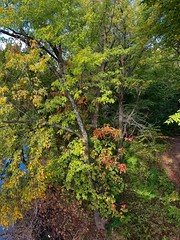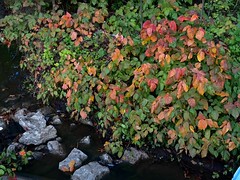October 27, 2013
I last visited Woolaroc in December 2010 and was lured back out there today by the Lewis & Clark Corps of Discovery exhibition of 100 paintings by Charles Fritz, 14 paintings by Michael Haynes and 50 bronze sculptures by Richard Greeves. I was also interested in seeing renovations at the museum which have upgraded the lighting in several rooms. My photographs from the earlier visit showed how the old-fashioned lamps affixed above each large painting lit them unevenly; new track lighting on the ceilings has helped, although there are still some shadows.
I tagged along with John and Betty Henderson for the visit. On the drive in I saw live buffalo tongue and some stages of bison development. Inside I enjoyed Joe Beeler‘s sculptures Whiskey Guard and Voices in the Wind, along with his painting Teton Sioux Hunting Camp.
I had a better view of William Robinson Leigh‘s great paintings than ever before, thanks to relocations and improved lighting: Pocahontas, Visions of Yesterday, Custer’s Last Stand, Westward Ho, and The Lookout. I neglected to get a shot of his Navajo Fire Dance, but I did get shots of two works by Thomas Moran, my favorite painter of landscapes: Ruins of an Old Church, Cuernavaca, and Grand Canyon.
Other paintings from the regular collections which I captured were Brothers by Nancy Glazier, Great Distance by James G. Swinnerton, El Capitan by James Fetherolf, Mount Corcoran, Southern Sierra, Nevada by Albert Bierstadt, West Wind by Wilson Hurley, Eanger Irving Couse‘s similar paintings of Mending the Navajo Blanket and of the same model holding a figurine, Governor of Santa Clara by Henry C. Balink, and The Rabbit Hunt by Bert Geer Phillips.
I found Charles Fritz’s paintings in the Lewis & Clark exhibit somewhat uneven in their facial accuracy, but several of his paintings were striking, including Cordelling the Red Pirogue, White Cliffs of the Missouri, which is an adaptation of other paintings on display of the white cliffs. I also liked The Arrival of Captain Lewis at the Great Falls of the Missouri of the scenery in Montana and his staging of Crossing the Most Terrible Mountains We Ever Beheld of Idaho’s Bitterroot Mountains. The most striking sculpture by Richard Greeves was Bird Woman of Sacajawea, with Jean Baptiste riding on a cradle board on her back.
Back outside the museum entrance, we found many ladybugs crawling and flying around the colorful mosaics. We walked past the pond to the lodge to enjoy the view of Clyde Lake. On the drive out, we admired a nice rack of antlers. It was a nice way to spend a Sunday afternoon.








